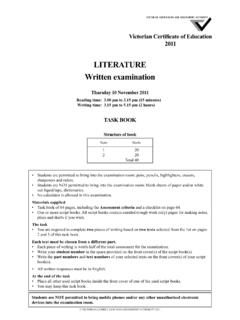Transcription of EXTREME ARTHROPODS: EXPLORING EVOLUTIONARY …
1 EXTREME ARTHROPODS: EXPLORING EVOLUTIONARY ADAPTATIONS TO POLAR AND TEMPERATE DESERTS Luke Sandro, Springboro High School; Juanita Constible, Miami University; and Richard E. Lee, Jr., Miami University Abstract: Arthropods in the Namib Desert face some similar stresses to those in Antarctica. Here, students investigate arthropods from both places, creating toolboxes necessary for survival in EXTREME environments. In this inquiry, Namib and Antarctic arthropods are used to illustrate several important biological principles. Among these are the key ideas that form follows function and that the environment drives evolution. In addition, learners will discover that the climate of the Namib Desert and the Antarctic Peninsula are similar in several ways, and that these arthropods have evolved some analogous adaptations. This investigation is a good introduction to the phylum Arthropoda, the most successful group of animals on earth, and spotlights the group s ability to occupy some of the most challenging niches on the planet (National Science Content Standard C; NRC 1996).
2 On the first day of this lesson , small groups of students design imaginary arthropods able to survive in either Antarctica or Namibia. On the second day, student groups use EVOLUTIONARY toolboxes to pick out appropriate adaptations for actual Namib and Antarctic arthropods, using a menu of authentic names, adaptations and photos. This inquiry involves the students in EVOLUTIONARY thought and allows them to collaborate on assembling adaptations, using aspects of technological design to overcome specific environmental problems (Content Standards A and E; NRC 1996). The Central Namib Desert The Namib Desert, on the west coast of South Africa (roughly 25 S, 15 E), receives about 23 mm of rainfall per year (Hachfeld and Jurgens 2000) and contains sand dunes of every known type, including some of the world s largest dunes. Almost all of the moisture available to the organisms that live here is in the form of fog, which comes about 60 nights each year.
3 Wind is also a major part of the dune environment; in addition to moving the fog, wind shapes the dunes and causes plant and animal detritus to collect on the dune slip-faces. Though relatively sparse, this nonliving organic matter is an important part of the dune food web (Cloudsley-Thompson 1990). Finally, temperatures in the Namib can be extremely high, reaching 45 C at the sand s surface. Tenebrionid Beetles of the Central Namib Numerous species of beetles in the family Tenebrionidae a group that includes mealworms exhibit remarkable adaptations to the conditions of the Central Namib. Namib tenebrionids have the highest body temperatures measured in any ectothermic animal, and come nearer their upper lethal temperature limit than most other ectotherms. To avoid the sand s extremely high temperatures they bury themselves under its surface, emerging periodically each day (Seely et al.)
4 1988). To conserve water, their Malpighian tubules (insect kidneys) produce nearly dry waste in adults, and larvae can actually absorb moisture from the air. Many tenebrionids also secrete a layer of wax that coats the exoskeleton, reflecting some of the sun s radiation and protecting beetles from water loss, abrasion and microorganisms (Chown and Nicolson 2004). Most of these species have extended lifespans of up to six years spent mostly as adults, allowing them time to gather the energy they need to reproduce (M. Seely pers. comm.). These beetles are flightless, having evolved fused wing covers; this may or may not function as an adaptation for water conservation (Duncan 2003), but makes sense for an insect that frequently buries itself in a windswept environment. A few adaptations of individual tenebrionid species are particularly striking.
5 Onymacris unguicularis, the fog basking beetle, stands on its head, collecting droplets of fog on its body that run down grooves into its mouth (Hamilton and Seely 1976). Onymacris bicolor has a partially white exoskeleton, reducing the amount of heat it absorbs from visible light. Both these beetles have evolved especially long legs; when they are overheated, they can temporarily elevate their bodies above the dune surface ( stilting ). In specific wind conditions, a few millimeters of elevation can significantly reduce their body temperature (Chown and Nicolson 2004). The flying saucer trench beetle, Lepidochora discoidalis, exploits the fog by digging long trenches in the sand perpendicular to advancing fog, from which it drinks condensed water droplets (Seely and Hamilton 1976). It is also able to listen to the wind while it is buried beneath the surface, only emerging when it senses that wind speed is high enough to blow the detritus on which it feeds free of the sand (Hanrahan and Kirchner 1997).
6 The Antarctic Peninsula The Antarctic Peninsula extends north from continental Antarctica toward the southern tip of South America. The islands associated with the Peninsula have three environmental characteristics in common with the Central Namib Desert: EXTREME wind, EXTREME temperature, and EXTREME aridity. Of course, in contrast to the Namib, the Antarctic Peninsula is cold, not hot: winter temperatures are well below freezing (-20 C and lower) for several months of the year. In many places, however, the Peninsula is very much a desert. Most of the precipitation is either locked up in ice or rapidly drains away because there is no soil to hold it in place. Summer thaws frequently make fresh meltwater available on the Peninsula. In addition, salty ocean water is splashed on organisms near island edges, so organisms living on these islands experience considerable fluctuation in the availability of fresh water (Block 1997; Convey 1997).
7 Antarctic Arthropods In this lesson , we focus on two arthropods found on islands surrounding the US research base Palmer Station (64 46 S 64 03 W): the wingless fly Belgica antarctica, and a springtail called Cryptopygus antarcticus. For the most part, these arthropods are considered to be pre-adapted to the conditions in Antarctica that is, the adaptations they possess were not evolved specifically in response to the Antarctic environment, but rather are commonly found in many closely related species on other continents (Block 1997, Convey 1997). Like Namib tenebrionids, neither of these Antarctic arthropods have wings. Antarctica is the windiest continent on earth, and the islands around Palmer Station are similarly gusty an arthropod with wings would be easily blown off these islands into the ocean. In fact, there are no flying arthropods native to Antarctica.
8 Also similar to Namib tenebrionids are the prolonged development times of Antarctic arthropods. Both Antarctic species live for two or more years, giving them time to gather enough energy during the short Antarctic growing seasons (Convey 1997). However, unlike Onymacris bicolor s white, sun-reflecting coloration, these Antarctic arthropods are both darkly pigmented, enabling some absorption of heat from sunlight. Belgica antarctica is the world s southernmost holometabolous (undergoing complete metamorphosis) insect, and is considered Antarctica s largest terrestrial animal (penguins and seals do not remain on land year-round). This wingless midge (Order: Diptera, Family: Chironomidae) is the only Antarctic arthropod known to be freeze-tolerant able to survive the freezing of its body water. It lives for two years, all but two weeks of which are spent in a series of four worm-like larval stages.
9 In its second summer, it pupates and emerges as an adult, which lives for about 10 days, during which time it mates and lays eggs (Sugg et al. 1983). Belgica synthesizes a variety of cryoprotectants ( antifreezes ), including glycerol, fructose, glucose, trehalose and sorbitol, which help it to survive internal freezing (Baust and Lee 1980). During the long winters, Belgica larvae are frequently encased in ice, and freezing causes extensive cellular dehydration as ice forms extracellularly (Baust and Lee 1987). They can also lose water quickly to the air, and survive the loss up to 70% of their body water it is, in fact, likely that Belgica dehydrates protectively, using lack of water to survive low temperatures (M. Elnitsky et al., unpublished data). The larvae can also survive immersion in meltwater and penguin guano, and tolerate wide swings in salinity, pH, and oxygen availability (Baust and Lee 1987).
10 Cryptopygus antarcticus is a springtail (Order: Collembola), a proto-insect that does not undergo metamorphosis. In other words, it grows in size but does not significantly change its body form throughout its life, which lasts 3-7 years. Unlike the midge, Cryptopygus is not able to survive freezing, and is thus considered freeze-susceptible. Rather, like other Antarctic arthropods, it can cool to -20 to -30 C without freezing! These springtails avoid freezing in part because they are very small: if you wanted to make a tiny droplet of pure water into an ice cube, you would have to wait until the water reached -15 C or below. Cryptopygus also can lower its freezing point by synthesizing cryoprotectants and clearing its gut of food particles that could act as nuclei for ice crystal formation. Finally, this species has a waxy, hydrophobic cuticle which enables it to float on water and avoid being encased in ice, and promotes the formation of large rafts of individuals on the surface of meltwater pools (Cannon and Block 1988).









